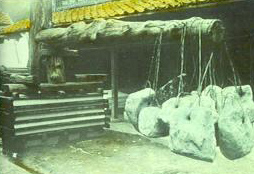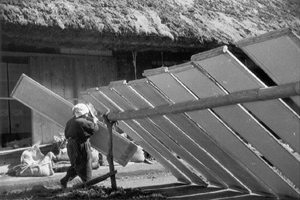Pressing
The freshly formed, wet stack of paper is then readied for pressing. Placing the stack of paper between wood in a press, pressure is gradually and evenly added to the stack in order to remove excess water without misshaping the new sheets. Each weight is added one at a time over a period of hours to prevent damaging the wet sheets.
The wet paper can require up to ten hours of gradual pressing. The neri helps make it possible to separate the sheets after pressing. A papermaker may also place a thin thread between the sheets to aid in the separation.

(text and background only visible when logged in)

Drying
At this point, despite having been pressed, the paper still has a high percentage of water. Each sheet of paper is carefully removed from the stack, brushed onto a board, and left in the sun to dry. Propped up against houses and fences, an entire yard or even hillside is turned white as the paper dries. A steam table may also be used to speed this process.
(text and background only visible when logged in)
Cutting
After the sheets are finished drying, a process that takes anywhere from minutes to hours
depending on the weather, the sheets are then cut to size. Wooden blocks are used for
measurement, and a very sharp knife, often curving in like a sickle, is used to make the cuts.
The cutting of the paper, like its formation, is an art all to its own. Around 200 sheets
of paper are cut at a time.
(text and background only visible when logged in)
Inspection
Finally, each new sheet of paper is inspected for irregularities. Any tiny imperfections are
removed, and the sheets are separated into piles according to quality.
The poorest quality sheets, like those made by beginners, are recycled to make the new paper.
Those that are deemed of lesser quality, but not recycled are often sold at discount. A new
batch of beautiful Washi paper is ready for sale and distribution.
(text and background only visible when logged in)